Why I Switched to This Polyurethane Alternative
Oil-based polyurethane has toxic fumes and can be difficult to apply. That’s why I switched to this safer, natural, easy-to-apply polyurethane alternative.
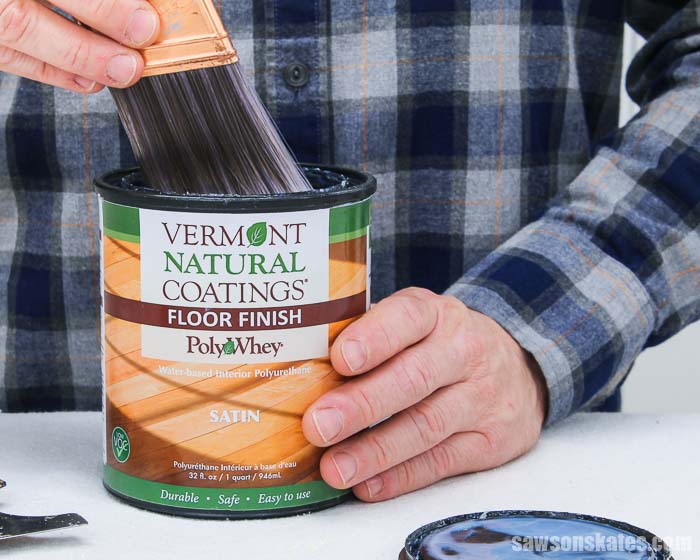
Safer Alternative to Polyurethane
Oil-based polyurethane is a great way to protect wood. But it has a few drawbacks. It has stinky, toxic fumes, it’s combustible, and it can be difficult to apply. Plus, sometimes it looks like a plastic coating has been applied to the wood.
A reader recently suggested that I give PolyWhey by Vermont Natural Coatings a try. I bought a quart and gave it a shot. Now I’m making the switch from oil-based polyurethane to this safer, natural polyurethane alternative.
PolyWhey is low odor, isn’t combustible, is easy to apply, and the finished product looks amazing.
This tutorial contains affiliate links to supplies and tools. Purchases made using these links help support the Saws on Skates website and allows me to share more projects and tips with you. There is no cost to you for using these links. Visit my site policies for more information.
Before we get into this polyurethane alternative, be sure to click the subscribe button at the bottom of this page to sign up for my FREE weekly newsletter loaded with helpful pocket hole tricks, space-saving workshop ideas, clever DIY tips and more!
Table of Contents
- My Journey With Polyurethane
- What Makes This Polyurethane Alternative Different?
- Is It Easy to Apply?
- Can You Apply it Over Stain?
- Can You Apply it Over an Existing Finish?
- Is It Combustible?
- Is It Low Odor?
- Does it Dry Quickly?
- How Many Coats Should You Apply?
- Do You Have to Sand Between Coats?
- How Do You Clean It Up?
- Would I Use This Polyurethane Alternative Again?
- Where to Buy PolyWhey?
- How to Apply PolyWhey
My Journey With Polyurethane
For as long as I can remember I’ve had a love/hate relationship with polyurethane.
I love how polyurethane protects wood projects. It resists heat and scratches, seals out water, dust, dirt, and grease.
But I’ve never been a fan of the stinky, toxic fumes. Or that it’s combustible. Or how it can be difficult to apply. Or how sometimes it looks like I applied a plastic-like coating to my wood projects.
For the longest time, I didn’t use polyurethane. Instead, I used this DIY finish.
Then, I learned I could use my paint sprayer to spray polyurethane. For me, spraying was much easier than applying poly with a brush.
Related: How to Spray Polyurethane
Recently, I’ve become more and more concerned about using all of these stinky, toxic chemicals. I’ve been on a mission to use less of these products and switch to safer, more natural products instead. First, I switched to natural stains like this coffee stain and this DIY black walnut stain.
Next, I started using Polycrylic to seal my projects. Polycrylic is water-based and doesn’t have any stinky fumes, but it’s not as durable as polyurethane.
Related: Polycrylic vs Polyurethane: Are They The Same?
That’s when a reader suggested that I try a different top coat.
Jack said:
You should take a look at this terrific line of products from Vermont Natural Coatings based in Vermont. It is a whey-based product that is environmentally friendly. I have used it on a couple of projects and it works fantastic and cleans up easily with soap and water. I highly recommend it. Check it out.”
Recently, I built this simple DIY desk and planned to use a clear finish on the table top. I thought this was the perfect opportunity to give Jack’s suggestion a try.
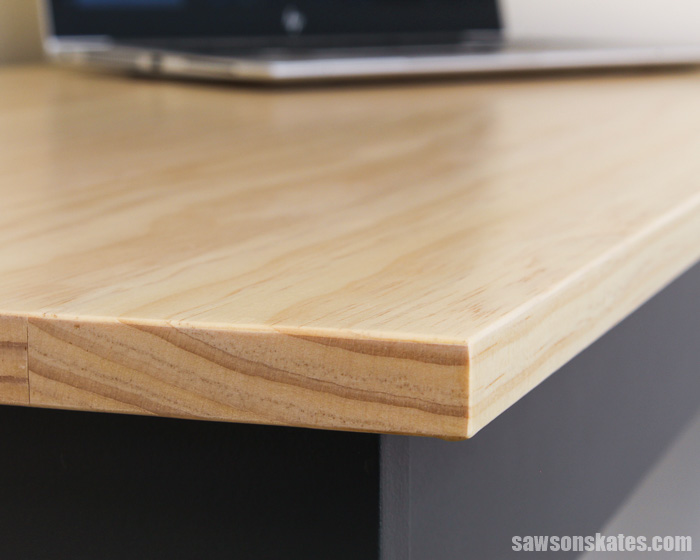
I bought the Vermont Natural Coatings PolyWhey at a hardware store. I wanted a satin sheen for the DIY desk. They didn’t have the satin furniture finish on hand, but they did have the satin floor finish.
The manager of the hardware store’s paint department told me the only difference between the furniture finish and the floor finish is the floor coating is more durable. I thought more durability would be perfect for the table top so I decided to give it a try.
Back to Table of ContentsWhat Makes This Polyurethane Alternative Different?
What makes PolyWhey different from oil-based polyurethane? Oil-based polyurethane is petroleum-based. In other words, it’s derived from crude oil.
PolyWhey is derived from whey. Wikipedia says whey is “the liquid remaining after milk has been curdled and strained.” Whey is a byproduct of cheesemaking.
Vermont Natural Coatings says their products deliver “professional quality results with unprecedented performance using safe, natural ingredients.”
In addition to being a safer, natural alternative to oil-based polyurethane, I found PolyWhey:
- Was easier to apply
- Didn’t have any stinky fumes
- Was easier to clean up
Plus, I was thoroughly impressed by the finished look of PolyWhey. It was smooth and didn’t have a plastic-like appearance that oil-based poly can sometimes have.
Back to Table of Contents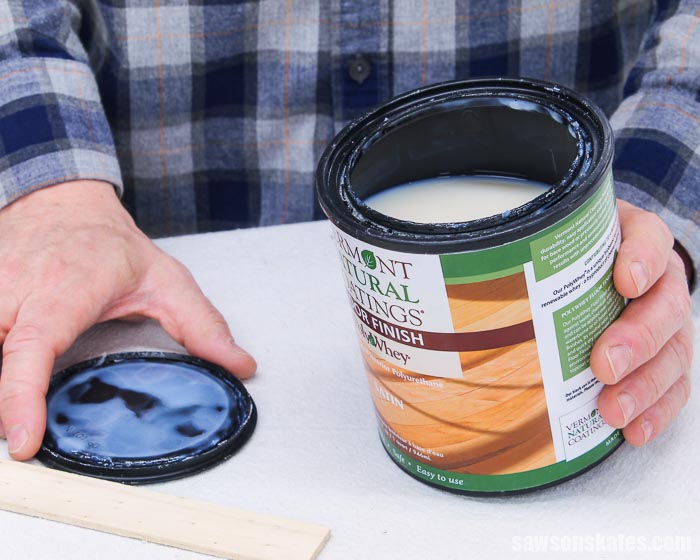
Is it Easy to Apply?
For me, PolyWhey was easier to apply than oil-based polyurethane.
One of the first differences I noticed between PolyWhey and oil-based polyurethane was the bubbles. Or rather the lack of bubbles in PolyWhey.
One thing we have to be careful with when applying oil-based polyurethane is bubbles. Bubbles can be introduced into oil-based poly by shaking the can, stirring too vigorously, or scraping the brush on the side of the can.
Those bubbles will end up on the brush and dry on the surface of the wood. Any bubbles will need to be sanded out before applying the next coat.
I didn’t notice any bubbles in the can of PolyWhey or on the surface of my finished project.
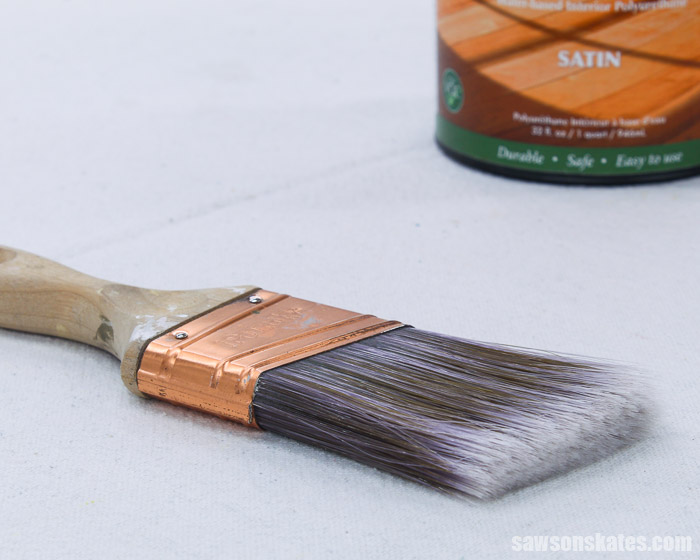
Another difference I noticed was how easily PolyWhey flowed on the surface of the wood. Oil-based polyurethane can sometimes feel like you’re brushing a thick maple syrup onto the wood.
Back to Table of ContentsCan You Apply it Over Stain?
Yes, PolyWhey can be applied over fully cured water-based and oil-based stains.
Back to Table of ContentsCan You Apply it Over an Existing Finish?
Yes, PolyWhey can be applied over fully cured water-based and oil-based finishes.
When possible, Vermont Natural Coatings recommends sanding to remove the old coating before applying PolyWhey.
If sanding the entire old coating isn’t possible, they recommend sanding where the old finish is worn. This helps to blend the edges and reduce the chances of flaking.
Next, remove the sanding dust with a ShopVac, wipe the surface using a cloth dampened with water, and apply the PolyWhey.
Back to Table of ContentsIs it Combustible?
Unlike oil-based polyurethane, PolyWhey is not combustible.
Back to Table of ContentsIs it Low Odor?
PolyWhey is low odor and has low VOCs.
When we open a can of oil-based polyurethane we’ll notice it has a strong odor. Oil-based poly is loaded with volatile organic compounds or VOCs. Tox Town (U.S. National Library of Medicine) says “Volatile organic compounds (VOCs) are compounds that easily become vapors or gases.”
Short-term exposure to VOCs can cause eye irritation, headaches, dizziness, and more. Long-term exposure can cause damage to the liver, kidneys, and the central nervous system. It can also cause cancer.
Back to Table of ContentsDoes it Dry Quickly?
Yes, PolyWhey dries in less than two hours but needs one week to fully cure.
Back to Table of ContentsHow Many Coats Should You Apply?
It’s recommended to apply three coats of PolyWhey.
Back to Table of Contents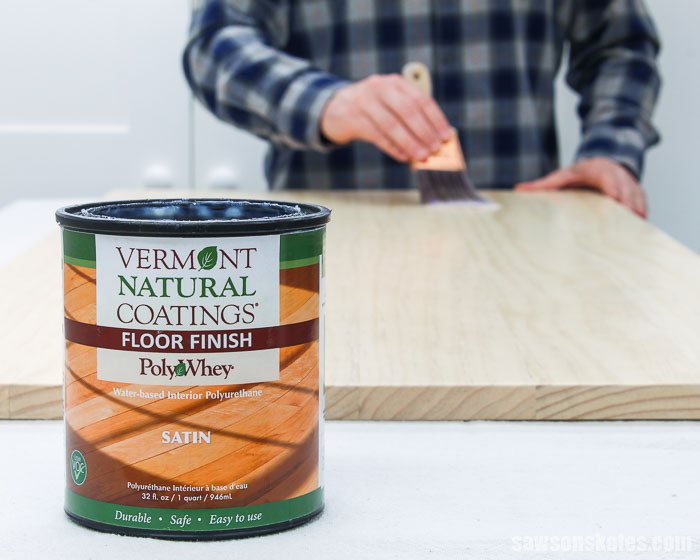
Do You Have to Sand Between Coats?
The first coat needs to be sanded with 220 grit sandpaper before applying the second coat.
But here’s the great thing about this polyurethane alternative. We don’t need to sand between the second and third coat if the third coat is applied within 24 hours of applying the second coat.
Even though in some cases sanding isn’t required, to achieve the smoothest finish, Vermont Natural Coatings recommends sanding between the second and third coats.
Related: 11 Secrets for Sanding Wood Projects Like a Pro
TIP: Don’t use steel wool to sand between coats when using water-based finishes. Water can cause steel wool to rust. If any of the steel wool is left behind it could cause a stain in the finish.
Back to Table of ContentsHow Do You Clean It Up?
PolyWhey easily cleans up with soap and warm water.
Oil-based polyurethane needs to be cleaned up with mineral spirits.
Soap and warm water makes PolyWhey easier to clean up.
Back to Table of ContentsWould I Use This Polyurethane Alternative Again?
Yes, I would absolutely use this safer, natural polyurethane alternative again.
I liked that this product is low odor, isn’t combustible, is easy to apply, and the finished project looked amazing.
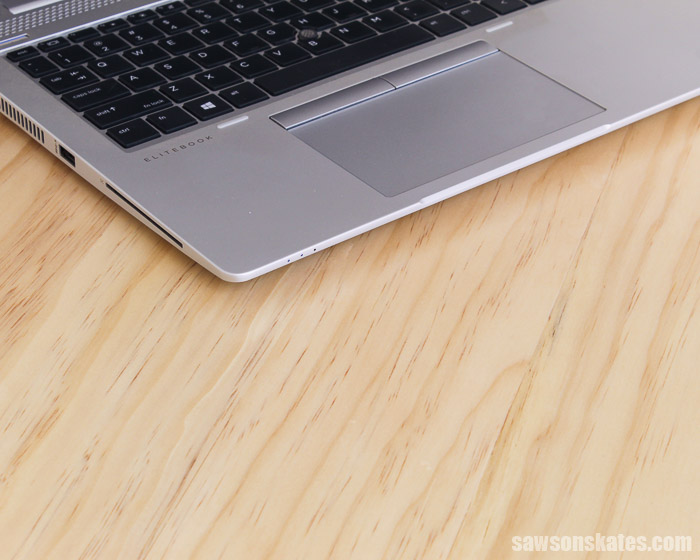
Where to Buy PolyWhey
I bought a quart of PolyWhey at a hardware store.
If PolyWhey isn’t available in your area, you can buy it online here and have it shipped to your home.
Back to Table of ContentsStep 1. Prepare the Wood
The first step to preparing any project for a top coat is to sand the surface of the wood smooth.
Related: 11 Secrets for Sanding Wood Projects Like a Pro
Step 2. Prepare the PolyWhey
This product collects at the bottom of the can so it’s important to stir it really well.
Be patient with this step. It took some time for the product that was collected on the end of the paint stick to blend into the rest of the product.
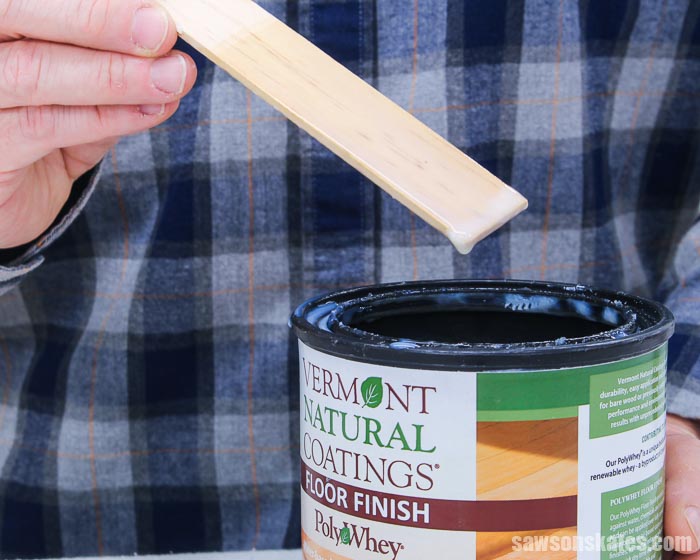
Step 3. Apply the PolyWhey
PolyWhey is as easy to apply as a quality latex paint. Apply thin, even coats with the direction of the wood grain. Overlap the strokes, keep a wet edge, and brush out any areas that puddle.
Step 4. Sand the First Coat
Allow the first coat to dry for 2 hours. Then, lightly sand with 220 grit sandpaper. Don’t use steel wool.
TIP: Don’t use steel wool to sand between coats when using water-based finishes. Water can cause steel wool to rust. If any of the steel wool is left behind it could cause a stain in the finish.
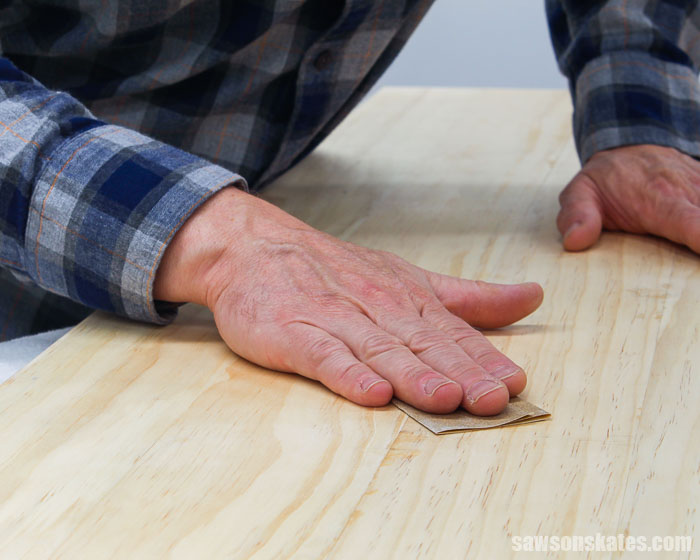
Remove the sanding dust with ShopVac and wipe the surface using a cloth dampened with water. Vermont Natural Coatings says do not use a tack cloth for this step.
Related: What is a Tack Cloth? (+ What I Used Instead)
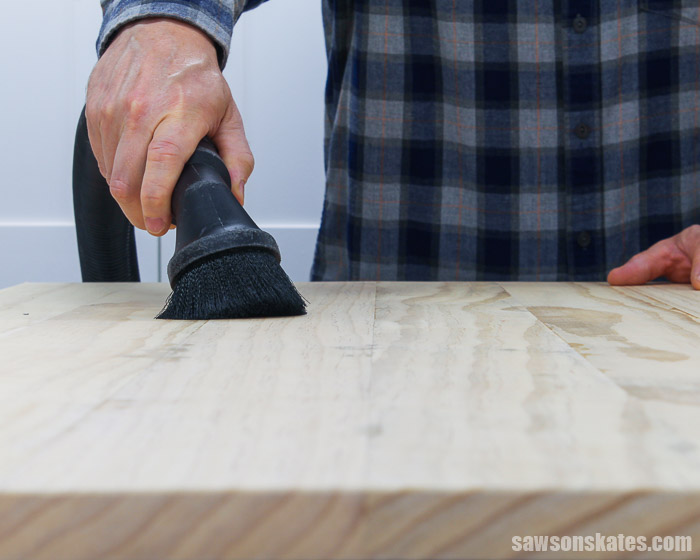
Step 5. Apply the Second and Third Coats
Apply the second coat just like the first coat.
Sanding is not required if you apply the third coat within 24 hours of applying the second coat. Just apply the third coat directly on top of the second coat.
However, to achieve the smoothest finish, Vermont Natural Coatings recommends sanding between the second and third coats.
Sanding is required if you apply the third coat after 24 hours of applying the second coat. Lightly sand with 220 grit sandpaper, remove the sanding dust with ShopVac, and wipe the surface using a cloth dampened with water.
Final Thoughts
PolyWhey by Vermont Natural Coatings is a safer, natural polyurethane alternative. It’s low odor, isn’t combustible, is easy to apply, and the finished product looks amazing.
Thank you for stopping by. If you enjoyed this tutorial, would you please take a moment and pin it to Pinterest? I’d really appreciate it!

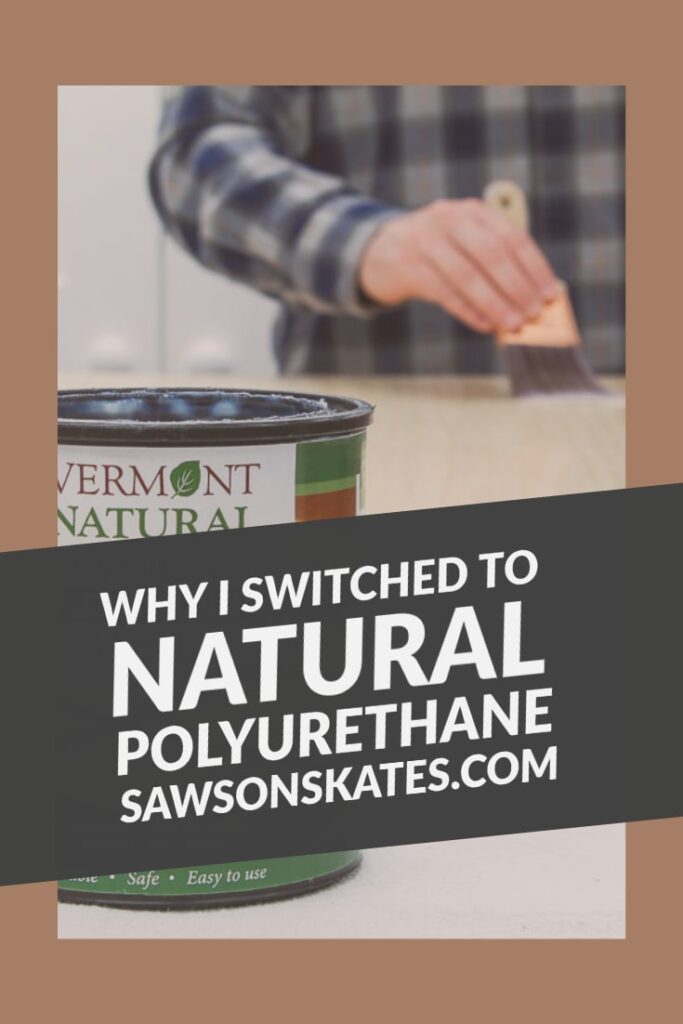
Can you spray it on?
Hi Armand – Yes, both the furniture and floor finish can be sprayed.
Interesting article, Scott, thanks for sharing. Is this strictly a coating for indoor products, i.e., floors, desktops, etc., and/or do they make similar product for exterior projects?
Hi Ron – The furniture finish and floor finish are for interior use, but they do have products for exterior use.
I’ve used Polywhey on a few projects — nice to work with and a very nice finish.
I was truly impressed with PolyWhey. I’m looking forward to trying some of the other Vermont Natural Coatings products.
Can this be used on outdoor items?
Hi Pete – The furniture finish and floor finish are for interior use, but they do have products for exterior use.
Is this food safe for cutting boards?
Hi Ken – This is not food safe and should not be used on cutting boards.
Very good article on finishing. My favorite product is shellac ever though it takes multiple coats. One project I even sanded down to using pumice stone. I hate polyurethane but have started to use water based poly with good results. For outdoor projects: marine varnish. My most recent discovery is pore filler (grain filler) and every projects except cutting boards gets some.
Been working with Polywhey for about a year now and will never go back to any other finish. I can now work in my workshop all year and not smell up the whole house.